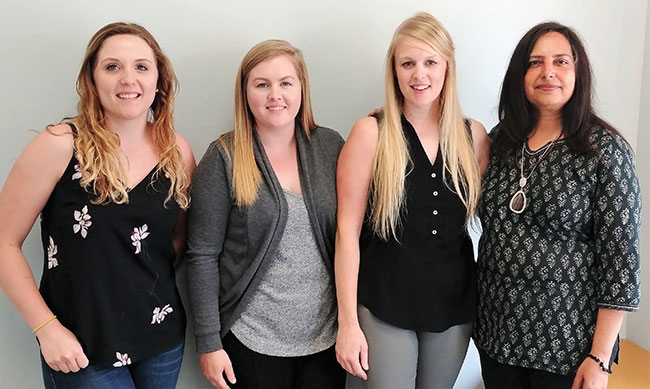
Features
Management
Operations
Hands-on and heart-to-heart
It’s no small feat to build a stable practice over time. A successful practitioner eventually develops enough professional relationships to serve a small practice population. But sole practice has its drawbacks – isolation can contribute to limited engagement, learning from others and professional self-reflection, suppressing a practitioner’s growth.
October 4, 2018 By Massage Therapy Canada Staf
 Above: (From left to right) Emily Hodgins (RMT) Massage therapist finds funding and
expands business
Above: (From left to right) Emily Hodgins (RMT) Massage therapist finds funding and
expands businessThe learning curve for developing a practice is large, and many mistakes are made. Fortunately for practitioners lacking capital, connections and business competence, some bright stars press beyond sole practice to broker opportunity for others.
With a large lease, commitments to utility companies, inflated marketing budgets and operating costs, massage business management is not for the faint of heart. Yet, for those massage therapists that do expand their business and invite others in, such a business contributes to the development and maturity of successive generations of massage therapists.
Stephanie Vandenbussche, RMT, seemed almost destined to take the leap. With some funding from Starter Company Plus, offered by the Ontario Ministry of Economic Development and Growth, as well as support from advisors and family, Stephanie expanded her operation. Her business supports four practitioners sharing three treatment rooms, serving the needs of a larger practice population. Her story is testament that it can be done.
Stephanie, who is in her 14th year of practice, lives with her husband and two children in Exeter – a town northeast of London, Ontario, with a population of 5,000 people. Initially, Stephanie split time between working from a home office and a second location. As her family grew, working from home was no longer possible. She leased space in a chiropractic office for six years before she launched her own business.
Besides practice aspirations, Stephanie had financial objectives as well. Being self-employed “with no pension to fall back on,” Stephanie realized she needed to work more, increase prices or expand. Faced with balancing time between a young family and work, she chose to raise prices and expand. She was motivated by a growing uneasiness she felt in turning people away. “It’s hard when someone in pain calls you for an appointment, and you admit you can’t see them for several weeks.” With the demand, she saw potential for growth. “I knew that if I opened a larger practice, it would be successful.”
Stephanie researched and applied for a Starter Company Plus grant to provide necessary capital to expand her physical business space and welcome more practitioners. While providing 40 plus hours of hands-on care per week and raising a young family, finding time to file the application was difficult. Stephanie spent many late nights preparing her application. Even after submission, there were updates to forward and emails to reply to, “to make sure I wasn’t at the bottom of the pile.”
The process of selection took over a year. Stephanie made the decision to proceed before the assurance of the grant. “I needed to believe in myself and believe I had a great business plan. I committed to following through whether or not I received the grant.”
Stephanie confesses she didn’t do this alone. She consulted several advisors along the way. “I believe hard work pays off, but I also know it’s important to surround yourself with people that have other strengths. You don’t need to do it on your own.”
Geoff Douglas, an advisor with Sunlife Financial, “is amazing with numbers and advice.” Douglas helped Stephanie set up essential insurance policies and a retirement plan. “I talked with Geoff a lot over the years. He encouraged me (to expand) and gave me the confidence I needed to put my plan into action.”
The second advisor was Don Dillon, a practitioner and coach in the field. “I love Don’s point of view and passion for our profession, and I liked the ideas he presented.” She continued, “Don encouraged me to clarify [the business model] I wanted to create. He helped me understand the value I could offer practitioners working in my office. [Don reminded me] my time in managing the business is worth something. When I take time after providing massage to make calls, procure advertising, create opportunities for associates, and manage all related bookwork…I should be paid for that time.”
Stephanie confirms she gained a lot of confidence from the process. “I began this process to create a better financial future for my family, something that will generate revenue when I can’t work as much. My business offers practitioners more than simply a room to work in. My ownership and experience create the difference…create a place practitioners want to work in.”
Stephanie’s motto is “hands-on and heart-to-heart.” From her business’s mission statement: “The goal of Exeter Massage Therapy is to use therapeutic massage therapy modalities to improve the wellbeing of individuals coming to us for health and wellness issues…to maximize quality of life.
We believe in developing and maintaining a collaborative relationship between client and professional massage therapist…having the client as a partner in the process ensures that the treatment, each time, addresses specific issues and concerns as they change and evolve.”
So far, Stephanie has received $3,700 of the $5,000 award, and has put it toward costs incurred while awaiting the award decision. “I needed to believe in myself and that I had a great business plan. [I was prepared to] follow my plan through, with or with out the award.” She continues, “If you’re not willing to do this, you shouldn’t consider expanding your business. The business plan really is the easy part.”
Print this page